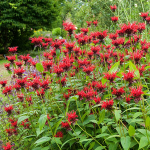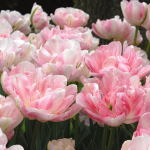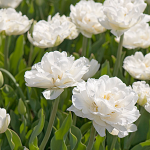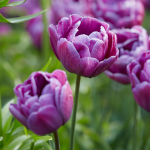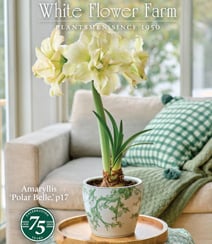Product Details
Our French Single Late Tulip Mix is a bright array of the longest-stemmed and most robust growers in the Tulip world. These are the Tulips bred to please the discriminating customers in French flower markets, where quality standards are uncompromising. Late. Not labeled. 25 bulbs cover 5 sq ft.
Tulipa is an enormous genus consisting of approximately 75 species, all of which are, in their original forms, true perennials. In their native habitats (ranging from Central Asia to the Mediterranean basin) Tulips are subject to both long, cold winters and hot, bone-dry summers; they adapted to survive these conditions by returning to dormancy after a spring season of active growth and flower. The cultivation of Tulips goes back over 1,000 years and the 14th century Ottomans are generally credited with the development of Tulipa as a garden plant.
The conditions in most North American gardens don't much resemble the climates in which Tulips evolved, and most modern cultivars are best grown as annuals - planted in the fall, enjoyed the following spring and then replaced. There are several groups, however, that do offer strong multi-year performance. Selections from the Kaufmanniana, Fosteriana, Greigii, and Darwin Hybrid groups are generally considered the most perennial and our Tulip growing guide includes information on the growing practices that are most conducive to repeat performance. In addition to these groups of garden varieties, there are less-hybridized varieties referred to as Species Tulips or Botanical Tulips. Species Tulips are the closest contemporary analogs to the original, "wild" tulip and are the most perennial of all commercially available varieties. They are generally smaller and more demure than the more highly-bred forms; some Tulip connoisseurs consider them the most attractive and garden-worthy of all.
We offer, in most years, more than 100 Tulip varieties, each chosen on the basis of its garden merits. Our descriptions indicate, whenever possible, the group to which the variety belongs and whether the variety is considered an Early, Midseason, or Late Bloomer. These designations are relative - Early, here in Connecticut, means April, Late means May, and Midseason means somewhere in between. Employing varieties from across this spectrum will yield the longest possible season of bloom and the longer one has Tulips in flower, we think you'll agree, the better.
Tall and elegant, Single Late Tulips bloom in late spring with large, goblet-shaped flowers on strong stems (24–30"). They come in a broad color range and are moderately perennial under ideal conditions. They are favorites for their height and grace, perfect for formal beds and late-season drama.
For information on Tulip care, click Growing Guide.
Shipping
HOW PLANTS ARE SHIPPED
The size of the plants we ship has been selected to reduce the shock of transplanting. For some, this means a large, bareroot crown. Others cannot travel bareroot or transplant best if grown in containers. We ship these perennials and annuals in 1 pint pots, except as noted. We must point out that many perennials will not bloom the first year after planting, but will the following year, amply rewarding your patience. We ship bulbs as dormant, bare bulbs, sometimes with some wood shavings or moss. Shrubs, Roses, vines, and other woody plants may be shipped bareroot or in pots. The size of the pot is noted in the quick facts for each item.
WHEN WE SHIP
We ship our bulbs and plants at the right time for planting in your area, except as noted, with orders dispatched on a first-come, first-served basis by climate zone. We also ship a wide range of containers and planters, tools, supplies, fertilizers, garden wear, garden decor items, as well as indoor decorations like wreaths and dried bouquets when available. Estimated dates for shipping are indicated in the green Shipping Details box for each item. Please supply a street address for delivery. Kindly contact us with two weeks notice, if you'll be away at the expected time of delivery.
OUR GUARANTEE
We guarantee to ship plants that are in prime condition for growing. If your order is damaged or fails to meet your expectations, we will cheerfully replace or refund it. Please contact our Customer Service Department at 1-800-503-9624 or email us at [email protected]. Please include your order number or customer number when contacting us.
Reviews
Average Customer Rating:
 (14 Reviews)
Write a Review
(14 Reviews)
Write a Review
Sort by:
great showing in year 2 
A viewer from Philadelphia, PA
7 of 7 people found this review helpful. Do you? yes no Certified buyer
Astonishing! 
A viewer from NJ
15 of 16 people found this review helpful. Do you? yes no Certified buyer
Hope these will rebloom in lower zone 8 
A viewer from Aiken, South Carolina, USA
Growing guide
Tulips today are available in many shapes, sizes, and seasons of bloom. The conditions in most North American gardens don't much resemble the climates in which Tulips evolved, and most modern cultivars are best grown as annuals - planted in the fall, enjoyed the following spring and then replaced.
There are several groups, however, that do offer strong multi-year performance. Species Tulips, Darwin Hybrids, Fosterianas, Greigiis, Kaufmannianas, and WFF Perennial Tulips can put on a stunning display for several years with your help. For the best display, avoid the "soldier effect" and plant the bulbs in clusters. Plant large bulbs 5–6" apart and smaller bulbs 2–3" apart. Small Species Tulips are ideal for rock gardens and the tall, large-flowered varieties can hold their own anywhere.
Light/Watering: Tulips perform best in full sun in the North and will tolerate very light shade in hotter areas. Unless the season is unnaturally dry, normal rainfall should suffice.
Fertilizer/Soil and pH: Tulip bulbs require a well-drained soil. Sandy soil enriched with organic matter is ideal as is a pH of 6.0 to 6.5. Keep Tulip bulbs cool (below 65°) until ready to plant. Plant in fall at least a month before the ground freezes. Follow directions for planting depth for individual varieties.
Pests/Diseases: Aphids may be a problem but are easily washed off with a water spray. If you notice spindly stems and white or yellowish mottling or streaking of the foliage suspect a virus and dig up and destroy the bulb. Occasionally an amber gel-like substance called gummosis is present on Tulip bulbs. It is not harmful and will not affect the bulbs' performance.
Companions: Tulips are lovely with other spring bloomers and with each other. Mertensia virginica is a sweet companion and Tulips are perfect planted beneath ground covers like Epimedium or Vinca. Underplant Tulips with Forget-Me-Nots for a classic combination.
Pruning: Direct energy to the Tulip bulb by removing spent blooms prior to developing seed capsules.
Cutting Flower Stems: Cut Tulip stems at the base of the plant during the coolest part of the day and when the bud is closed, but the color is visible. Re-cut the stems at a 45 degree angle underwater to prevent air bubbles from entering the stem’s vascular system, which can block water uptake. Tulips prefer cool, fresh water—not warm. Change the water daily to reduce bacterial buildup. Keep Tulip bouquets away from ripening fruit, especially apples and bananas. Ethylene gas emitted by fruit will shorten the flowers’ vase life.
If cutting perennial tulip stems, leave at least 2 to 3 individual leaves per bulb. Each leaf is a valuable energy source that helps recharge the bulb for next year’s bloom. Removing too many leaves deprives the bulb of the energy it needs to rebuild, which leads to smaller blooms or no flowers the next year.
Calendar of Care
Early Spring: Fertilize bulbs now with a suitable formulation.
Mid-Spring: Enjoy the show and cut flowers for gorgeous bouquets. Watch for aphids and wash off if present.
Summer: Deadhead Tulip plants to remove developing seed capsules. Do not water Tulip beds, as most varieties prefer to stay dry in summer, and keep beds weeded. Do not remove foliage until it has yellowed completely.
Fall: Plant new bulbs at least a month before the ground freezes and water in. Check pH and adjust to 6.0 to 6.5. Fertilize established plantings now.
In parts of the country where winters are mild, Tulips may not receive enough natural cold to stimulate proper growth and flowering. We recommend treating these as annuals and replacing them with new bulbs every year. If you’d like to prechill bulbs during winter, you can do so by placing them in a refrigerator, away from fruits and vegetables (these produce ethylene gas, which can harm the embryonic flowers inside the bulbs). Make sure the bulbs remain dry. The usual prechilling time is ten weeks or longer at 40 to 45°F. Once the bulbs are removed from cold treatment, plant them right away. Bloom occurs about six to eight weeks after planting. Discard the entire plant after bloom.
Some Tulip varieties are excellent for forcing. Rooting time is from fourteen to sixteen weeks. More information on forcing bulbs may be found on our website.

